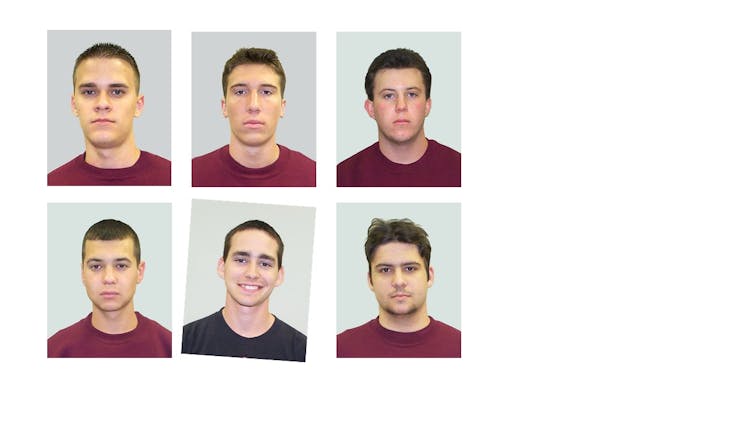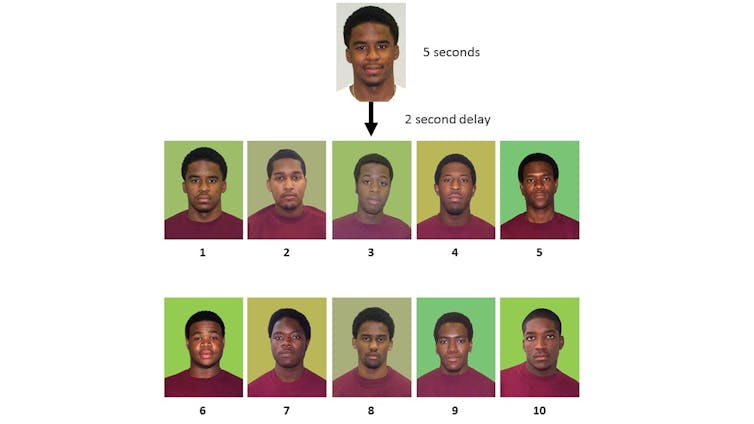Identification parades can be powerful evidence in securing convictions in criminal cases. But eyewitness evidence is notoriously prone to errors – and organisations such as the Innocent Project have found out that 70% of wrongful convictions that were later exonerated had verdicts based on faulty eyewitness evidence which resulted in mistaken identity.
Now our new research shows that small variations in the background colour of photo lineups can increase errors in identification of innocent suspects. We also added to the mounting evidence that shows people are worse at correctly identifying individuals who are of a different race to them.
Traditionally in the UK, lineups were conducted “live”, using the suspect and then several volunteers that were found on the day that resembled the suspect. But live lineups were often cancelled due to logistical problems. In a bid to reduce cancellations and make lineups fairer for suspects by finding more suitable volunteer stand-ins, for the past few decades lineups in a number of countries in Europe, the UK and the US have used photo lineups or video parades.
Risk of bias
Photo or video lineups do have some benefits over live lineups. Identification can take place more quickly after the crime. The foils in the lineup – the other members of the lineup than the suspect – can also be selected from a large database of images, rather than requiring police to find members of the public who resemble the suspect. Yet, although research does seem to suggest photo or video lineups can be fairer and less likely to result in mis-identifications compared to live lineups, there are ways in which a lineup could still be biased.
The instructions given to the witness can make the witness more likely to choose someone from a lineup, even when the lineup contains an innocent suspect. As a result, in most lineups the witness is told “the person may or may not be there”. Lineups can also be biased in the way that they are constructed. For example, the suspect could stand out if their image differs from the other lineup members, such as the suspect’s image being at a different angle to the rest of the photos, or having a different facial expression.

Another way the suspect may stand out from the other foils is if they are filmed on a different background from the other lineup members. Although lineup photographs are taken against a standard background, often a screen or a wall, natural variations in lighting or using different cameras can result in slight differences in the hues of background for different individuals. Our recent research looked at whether such variations in the background colours of police identity parades affect the accuracy of witness judgements.
We presented participants in our study with a target face for five seconds. A lineup of 10 faces then appeared and individuals had to decide if one of the 10 faces was the face they had previously seen – and, if so, which face it was – or if the target face was absent. Half of the faces presented in the lineups all had exactly the same backgrounds and half were on backgrounds of slightly different hues of green.

For some of the lineups, the target face or “guilty suspect” was present and in others, they were absent – representing the conditions of an innocent suspect in a criminal investigation. Previous work we conducted showed that witnesses are better at identifying a culprit who is of the same race as them and more likely to misidentify a culprit who is of a different race. This bias is referred to as the “own-race bias”, or “cross-race effect”. To investigate this, in our study we used some photos of people who were the same race as the participants – in our case Caucasian – as well as some photos of black people.
Background matters
We wanted to see whether the different backgrounds would influence how accurate people were at identifying people of the same race and of a different race. We found that, in cases where the lineup didn’t contain the target face, there were more false identifications when the lineup backgrounds varied, regardless of race.
When the lineups did contain the target face, overall there were no differences in correct identifications depending on whether the background varied or not. We also confirmed the persistence of own-race bias, meaning that our participants were more accurate at identifying suspects of their own race compared to other races.
Our research seems to suggest that variations in the backgrounds of photographs might not greatly influence identification when a guilty suspect is placed in a lineup. However, if a suspect who is innocent is placed in a linuep, and the backgrounds of the photos vary, there is a greater chance that an innocent suspect will be picked out.
Our findings could help reduce cases of mistaken identification that could lead to wrongful convictions. Although there are some factors, such as own-race bias, that can’t be controlled by the police, other factors such the backgrounds of photo lineups can be controlled. Ensuring witnesses choose a suspect because they recognise a suspect’s face, rather than disparities in the way the lineup photos are displayed, could help to reduce the false identification of innocent suspects.![]()
Catriona Havard, Senior Lecturer in Psychology, The Open University and Martin Thirkettle, Senior lecturer, Sheffield Hallam University
This article is republished from The Conversation under a Creative Commons license. Read the original article.